When you think of the American frontier, images of the Wild West may come to mind — vast, sweeping landscapes as far as the eye can see, cowboys and Indians riding horses, often engaged in territorial wars. The English, a six-episode miniseries on Amazon Prime Video, offers a revisionist approach to the classic western, one in which the hero happens to be Native American.
The show stars Emily Blunt as an Englishwoman, Lady Cornelia Locke, who comes to the West in 1890 to avenge the death of her son. There she meets Sgt. Eli Whipp/Wounded Wolf (Chaske Spencer), a member of the Pawnee Nation, on his way to Nebraska to claim the land owed to him for his service in the U.S. Army, despite being warned that the white men have no intention of honoring their debt to him.
What also sets this unique western apart is that it was shot in Spain, which provides the show’s stunning scenery. The gorgeous imagery comes courtesy of Spanish Cinematographer Arnau Valls Colomer (Tom Clancy’s Jack Ryan, Black Snow). Born in Barcelona, and schooled in film in Poland, Colomer was always fascinated by American storytelling in the European tradition, which made him the perfect choice for The English, though his connection with Blunt’s husband didn’t hurt, as he had previously worked with John Krasinski on Amazon’s Jack Ryan series. In fact, Colomer is currently lensing additional scenes for the Krasinski-produced thriller Apartment 7A, which is believed to be a prequel to Rosemary’s Baby starring Julia Garner.
Below the Line spoke with Arnau Valls Colomer from his home in Barcelona via Zoom, but before we dove into our discussion about The English, he revealed that he is a partner in two restaurants in Barcelona, where he modestly admits that he’s one of six partners, and “I don’t do anything. I’m just, like, inviting friends, and having food.” Perhaps he could provide Craft Services on his next production, given his culinary zest.
When we spoke, there was an excited boyishness about Colomer as he described his passion for the story and the camera styles he used to realize the vision of its creator/writer/director Hugo Blick. Even Colomer was humbled by how beautifully locations in his country doubled for the West, though he also revealed the challenges presented by the series, including working with horses, and, of course, mother nature, which brought unpredictable wind patterns that nonetheless helped illustrate the lawlessness of the Wild West.
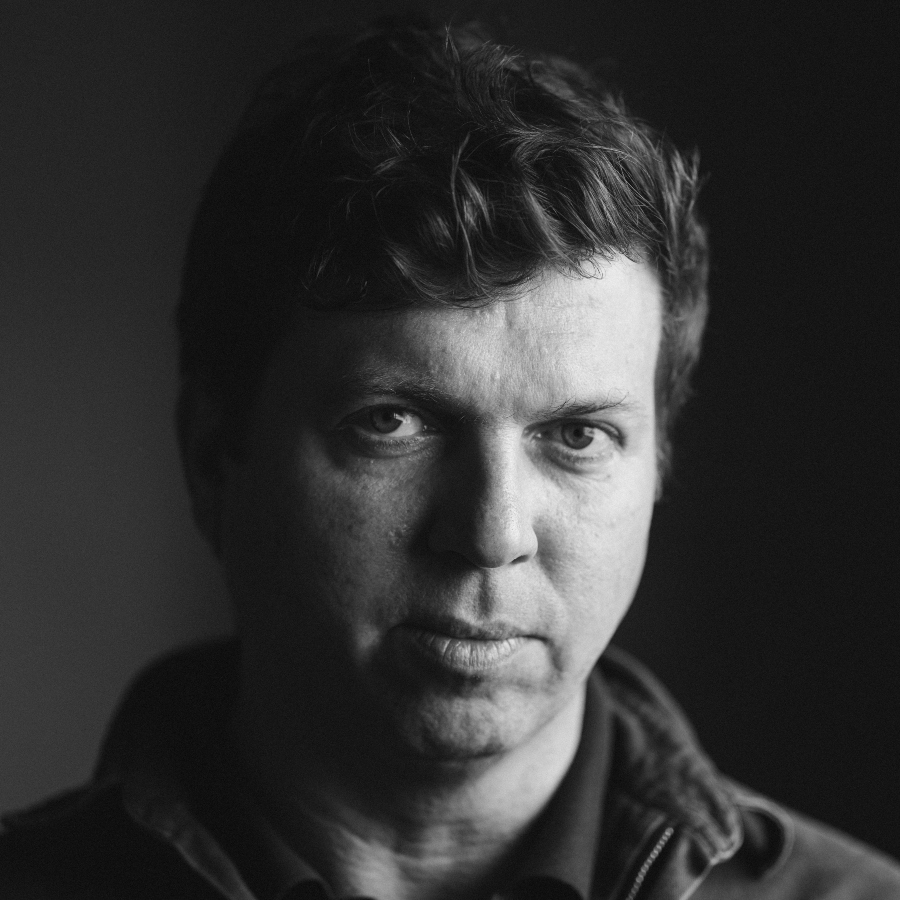
Below the Line: How did you come to the project?
Arnau Valls Colomer: They were changing locations. They didn’t know where to shoot, and suddenly they decided to shoot in Spain. I was coming back from the States to Spain, and it was like, “Oh, now it’s going back to Spain.” Maybe it’s a good idea.” Emily [Blunt] suggested me to the director (Hugo Blick), and then we did an interview. I read the scripts, we talked, and we immediately clicked on the references. It was kind of like an immediate match with Hugo, with an understanding of the film and the classic approach. He’s very graphic and visual, so he would put us in situations that were visually interesting right away from the beginning. So then it’s nice and easy to construct from there.
BTL: Coming from Spain, how did you tap into this very sort of English/American story?
Colomer: Yeah, it was strange. I mean, I come from Spain, I studied in Poland, and I was living in the States. When I came back, it was kind of like a perfect mix of things for me. I think it has a European approach. If we had shot that in the States, it wouldn’t have looked that way. It was very interesting, but learning the story took a long time for me because the scripts are deep and complex, and the plot is not simple. I’m happy to hear now all these things saying, “I had to watch twice to really fully understand” because the first episode is so important and you’re not aware of it when you’re watching it, so you have to go back to this. I was happy because I thought this [might be my] English problem. This is like a language thing that I have that I’m not fully understanding, but it’s just that it’s deep and complex.
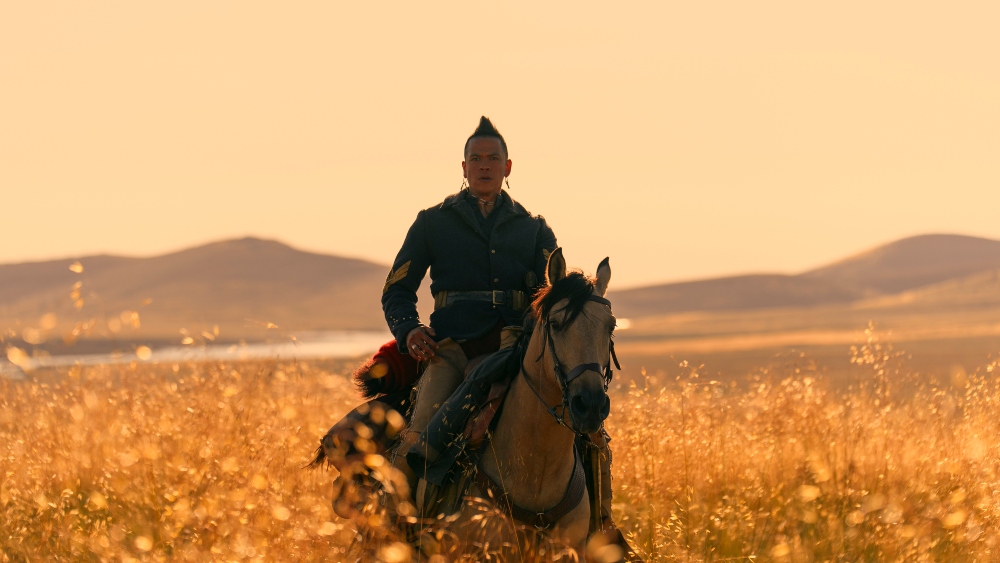
BTL: What research did you do for a Western film inspiration?
Colomer: It was a fun process researching and re-watching all the classics. [Akira] Kurosawa became a big reference for the framing and for this kind of super-well-composed static-ness and waiting and the building up of the scenes. Shane also served as a good reference for the framing and tone. Hombre, the Paul Newman film, [and its] director (Martin Ritt), was a very good reference. I was attempting to make a film similar to how it would have been shot in the 1950s and how we can translate it in the modern day.
BTL: What were some of the locations in Spain that you used and how did you double that for the West?
Colomer: When I read the script, I was like, “How are we going to do that in Spain?” It’s such a dramatic Western story. Looking at the locations and now watching the whole film, I’m still amazed that this is done in Spain and I did it. I’m from Spain; it’s like a triple contradiction. So the story goes from New Orleans all the way up to Nebraska, and what we did was basically go from South Madrid, Castilla-La Mancha, to North Madrid, Castilla y León, like from the more plain and browning style of Castilla-La Mancha to the more rocky and green style of Castilla y León. We did find a couple of big places that were basically a backlog for us, where we would build one town here and one town there. We arranged these mills there, and we put the snow mountains there, and this could work for this moment. So it was a bit of a puzzle.
BTL: Tell me some of the tricks that you use to make it look like an American western.
Colomer: We brought in this lens style and made it look like a western, and it does look like a western. We took a very traditional approach. To me, the question was like, “Okay, let’s do an homage to this, but let’s not be vintage.” “Let’s bring it up to date, to modern audiences.” So we shot digitally with the Sony Venice, but the lenses were very classic, like the primo classic anamorphic Panavision lenses, which are the size of a beast! Also, because we knew the style would be very static and observational, we decided to let things happen or stage things happening in front of the camera rather than chasing it or trying to find it; we staged every scene for ourselves. As a result, it appears to be very classic.
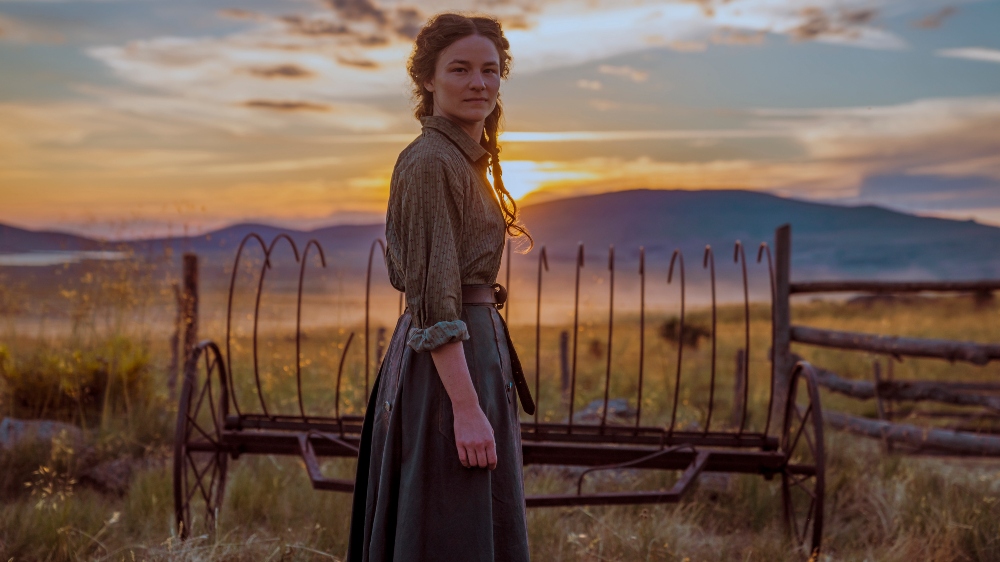
BTL: Some of the sunset shots were absolutely stunning, as were the night scenes. Describe how you shot them.
Colomer: With the sun and the skies, we were very lucky. You have these night scenes where it’s written, “Under the stars, they’re looking at the stars,” and you’re like in the middle of a field in the open air in the middle of the night. You don’t want them to appear to have been deleted by the stars. This is kind of frightening for a DP. You feel stupid at night because no matter how many lights you have, in these vast spaces, you end up in total darkness, so it’s difficult to control the nights in these huge, middle-of-nowhere places. It’s like figuring out how to make that look believable while also magical and poetic. So you have the space for some kind of filmmaking tone, but it has to be real at the same time. I was like, ‘How do we approach that?’ If we were in the 1950s, they would probably build this interior and just paint the background and stars on it. So I took that idea and said, ‘Alright, let’s build that in the studio and put [up a] blue screen, and then we’ll go to location and shoot day for night for the background, and we [can] insert that background on our blue screen that is shot and lit in the studio.’ So it looks like this kind of mixture of techniques is old-fashioned, but for a modern audience.
BTL: Describe how you mixed the classic with the modern cameras.
Colomer: I had these ideas about the technicolor look, how it translates to a modern wall, how the color blue and skin tone were in technicolor, and how we could do that in digital. Then we add a texture, a “live grain” effect over everything, where you have software that reacts to light and applies grain accordingly. The style was like a silhouette, well-composed and static.
BTL: Well, that’s interesting because the landscapes are so expansive that you shot and you’re saying that it all came to you. It must have been so well choreographed beforehand.
Colomer: It is and it’s not. Also, if you think about it, it’s kind of easy because once you decide on the landscape, and also because we’ve played in that time and area of the United States where there was like very little built. So it’s very much like nature, and it’s about framing towards the sun. “Okay, this scene is going to go like this, and they’re going to meet here, we’re going to frame there, and we’re going to do that at the end of the day.” It’s like, let’s do the coverage during the day and block the light as it was at the end of the day. And then let’s wait for that moment that we know is going to happen. It was well planned, but it looks more planned than it is because the landscape gives you so much that it’s about knowing where your master shot is that explains the story and gets a nice composition, and then working as a classic coverage from there.
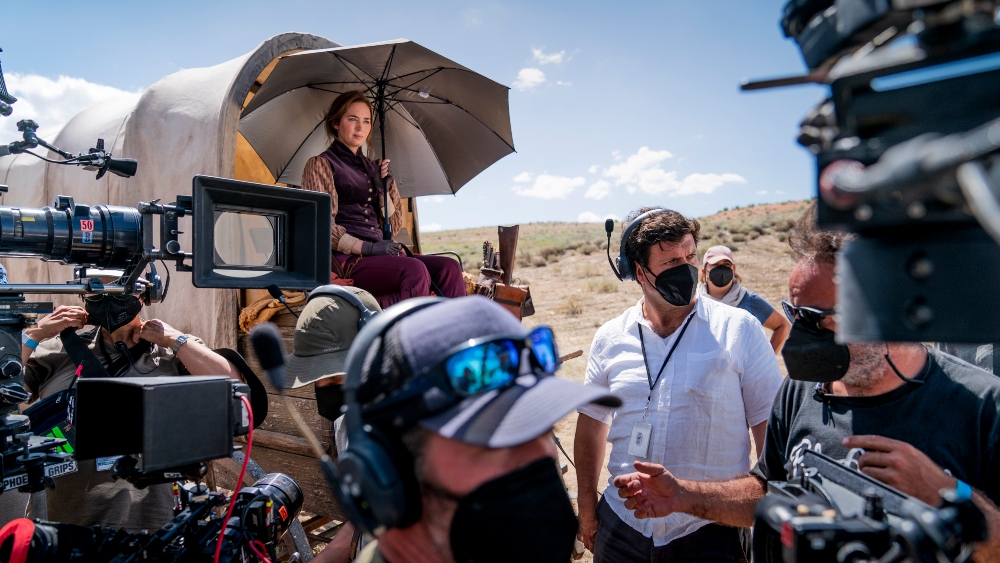
BTL: Talk about shooting the horseback riding scenes. Was that really Emily Blunt in a full-on gallop?
Colomer: She was the best rider of all the actors. She did train, and she did it all herself. We did have doubles for stunts such as going full speed. When you see her, like in a wide shot, coming to you and stopping, it’s all her doing that. And she was very good with the horses as well, like understanding the horse and building a relationship. She was the best at actually doing that. [chuckles]
BTL: Did you have any difficulties filming the horses?
Colomer: Oh yeah. I mean, it’s difficult. It’s difficult to film animals. You have a horse master who tells you what you can do and what you cannot do. It’s also difficult to frame a horse. It’s easy to frame in a wide shot, but when you’re close, it’s difficult to compose a horse and a human because the sizes are so different. The horse’s head is so big, and how do you compose that? Or when you decide to get off the horse, put the saddle on, and you’re not on the horse, how do you do all this? Learning to shoot a western is a process. Someone once said you only get to learn to shoot a Western after your third one. I did learn a lot. We did learn a lot about horses and, for example, how a horse falls. How do you go about doing that? These scenes are very storyboarded, so we know, “Okay, the horse has to fall in this shot,” so they prepare the land for that. They softened the land completely, and then they trained the horse to fall into that position. And so you frame that the day before and say, “Okay, the fall is going to happen here, and I want this angle.” So it’s a process.
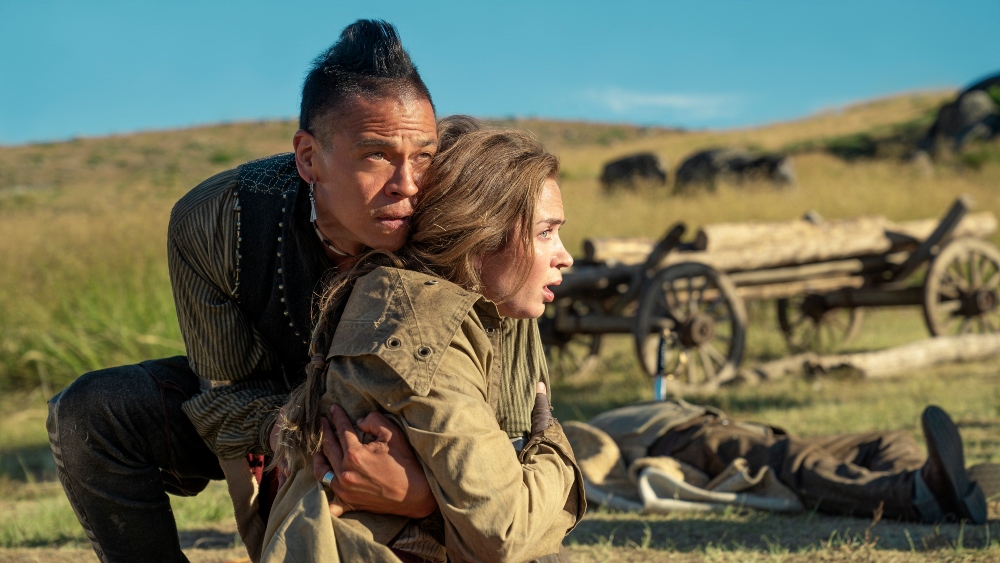
BTL: What were some of the other challenges that you came up against filming this?
Colomer: The weather. Because you are exposed to weather conditions, you should use the weather wisely and try to accommodate it, rather than fighting it, and make the most of it. Like, there was a moment that was full of red flowers in a field that we were not supposed to shoot, but, okay, this is amazing, let’s use that. And to use that as a character, as well as nature. I remember, for example, how the wind itself, like the wind sometimes, can become a problem with the face and all. But at some point, someone on the set said the wild wind gives you this wilderness, and it’s true. Emily’s hair is fighting the wind. It also indicates that you are in the middle of a wilderness area surrounded by nature.
BTL: What do you hope audiences come away with after seeing The English?
Colomer: I think they’ll love the story, and I think they’ll love the acting, and I think they’ll love the landscape and the way it’s done. It’s a very nice poetic story and not new at all, but in a way, it’s new because it’s a new version of these old classics that we know. It’s a new point of view on this classic filmmaking that you don’t see that much on TV nowadays, and it has this old-fashioned look that reminds you. The story is a chase, but it is full of subtle and quiet moments and tells you so much about your own society and makes you think about the scenes of that society and the scenes of the birth of a nation, making you think about a lot of things. All the characters that appear give you a very deep sense of time and place.
BTL: When you watch it, are you able to divorce yourself from the work you did?
Colomer: Normally, with the films I do, it takes a while to do that. It takes, like, three years. With this one, it was faster. I mean, actually, I watched it with some friends in England, and I watched it all completely enjoying it as an audience. Normally, with others, I only see mistakes, but with this one, because I liked it so much, I embrace the mistakes. I see them, but I like them. And overall, I’m so proud of the whole thing. It’s been a magical project.
The English is now streaming on Prime Video.





